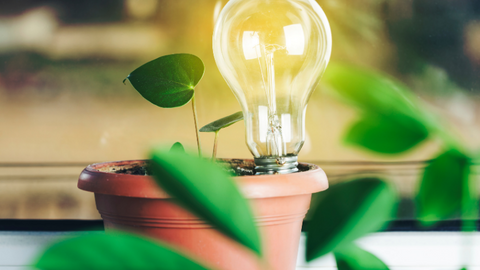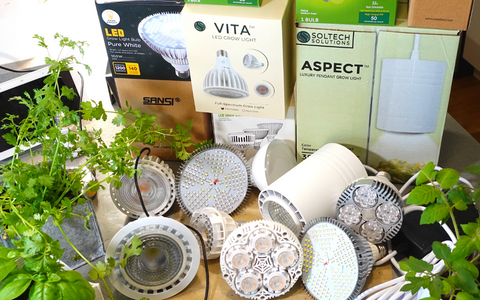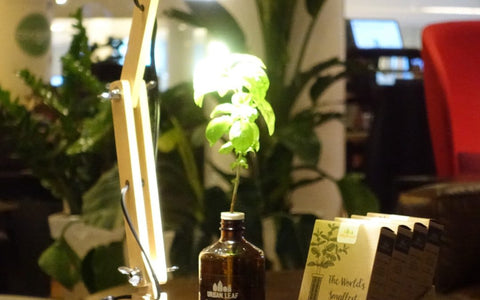If you're spent anywhere between 5 minutes and 5 hours learning about Grow Lights for Indoor Plants, then we're willing to bet you're feeling pretty confused by all the terminology. Watts, PPF, PPFD, PAR and DLI. What do they all mean, and why should you care?
In this article, we’re going to:
- Explain what all of these terms about indoor grow lights mean and why they are important.
- Show you how these terms are measured and related, as well as
- Give you some worked examples that you can apply immediately the next time you go shopping for a grow light for your indoor garden
Buckle up, fellow plant nerds. Let's dive in!

Ok, so the first thing you want to do is take a minute to digest the diagram above. We’ve laid this article out in the same way as the diagram above. That is, we will follow the ‘flow’ of the energy from the socket in your wall, through the grow light, and ending on the leaves of your plants.
If at any point you're feeling over whelmed and feel life you need to take a step back, then we recommend you check out ‘Grow Lights - An Introduction For Indoor Gardeners and their Plants’
How Much Electricity Do Grow Lights Use?
Why Grow Light Wattage Is Not As Important As You Think
The energy that we use for grow light indoors starts off as a watt.
A Watt is the global standard for measuring the rate of energy transfer. One watt is equal to one joule per second.
Wattage measures a rate of flow. If we were talking about water, we’d measure flow in litres (or gallons) per second. With electricity, we use Watts.
1000 watts = 1 kilowatt (kW). If you left an appliance that consumes 1kW of energy running for an hour, you’d have used 1 kWh. If you pull out your utility bill, you will likely notice that they are measuring your electricity consumption (and charging you) based on your kWh consumption. You will probably also see the price per kWh - and if you’re in the US this may be in the $0.08 - 0.28 range.
To put this into the context of a grow light for indoor plants, it’s useful to consider a simple example.
- Let’s say we have a grow light that consumes 20W. That is equivalent to 0.02kW.
- If we left that grow light on for say 14hours a day, then we’d be consuming 14 x 0.02 = 0.28KWH per day.
- Do that for an entire year, and we’d use 102.2 KWH.
- The average price of electricity in the US in 2019 was $0.1054, which means that the average cost of running a 20W grow light at 14hrs/day for an entire year in the US would be 102.2 x 0.1054 = $10.77.
You should use the electricity price listed on your utility bill to do this math yourself, but if you don’t have that handy the US Energy Information Administration has a handy list here.
Ok, so we now understand grow light wattage and how the energy coming out of our wall socket is measured. All we really know at this point is how much it is going to cost us to operate this grow light. We don’t know anything yet about how well this grow light is actually going to work for growing plants.
What is the Meaning of PPF in Grow Lights?
In order to know how effective a grow light is at growing plants, we need to understand what is its ‘efficacy’. That is, how efficient is it at converting the Watts we’re putting in, with plant-available light that comes out. The next unit of measure we need to understand is PPF.
PPF (photosynthetic photon flux) is a measure of the number of photons that are emitted by a source of light. PPF is measured in umol/s. For grow lights, our main priority is roughly 400nm to 700nm. Light within this range is called PAR, or ‘photosynthetic active radiation’. PAR is not a unit of measure like “watts” or “pounds”, rather, it is a qualitative assessment we use to define a certain type of light.
Side note: in more recent times the plant world is coming to understand that light frequencies outside the PAR range do actually have some benefits. More on that here, if you're interested.
Anyway; Watts go IN to a grow light. PPF is what comes OUT. To understand the efficacy of a grow light, we simply divide one by the other - i.e. PPF per Watt or PPF/W.
What is Grow Light Efficiency and PPF/W?
Indoor grow lights vary tremendously in terms of their PPF/W. There are many reasons for this, the most significant of which is cost. Especially when it comes to LED grow lights, older models and less efficient models are typically much cheaper.
The chart below summarizes PPF/W for a number of grow lights that are sold on Amazon today. You'll notice it's a fairly wide range. You might also notice that we include this PPF/W metric on all of our Grow Light Product Listings here at Urban Leaf.
The most efficient indoor grow lights we tested offer 10 times as much light output, for each Watt they consume. Wow! You want to know what’s even crazier? The worst grow light on this chart currently sells for $30 on Amazon and has over 7000 reviews. In our view, it is a total waste of time. The grow lights we offer here at Urban Leaf have been reviewed and vetted by Horticulturists and Plant Experts with combined 30+ years experience. We hate to be cliche - but like most things in life, you get what you pay for.

Grow Lights and the Coefficient of Utilization Explained
The other metric we need in order to translate Wattage into PPF available for the plant out is known as the co-efficient of utilization.
Coefficient of Utilization (CU) is a measure of how much light that exits from a fixture will fall on an area of a certain size. In other words, how much of the PPF that the light is producing actually makes its way towards the plant.
Imagine for a moment that we live in a 2D world had a light that was emitting light in all directions evenly. Let’s also say that the indoor plants we are trying to grow occupy an area below that light, and are sitting in an area which is equivalent to 90 degrees. Since the light is being emitted evenly in 360 degrees, this would mean that our CU is 0.25. The other 75% of the light is essentially wastage, or spillage.

Combining PPF/W and CU into an example
Let’s put these pieces together with an example.
Lets start with two grow lights - A and B. One uses 100 Watts and the other uses 50 Watts. Well, if you believed what you read on Amazon, then the 100W light must be twice as good as the 50W light. Right? Wrong. Allow us to explain.
| Units | Light A | Light B | |
| Energy consumption | Watts / j/s | 100W | 50W |
| PPF/W | umol/j | 0.25 | 0.75 |
| CU | multiple (0 to 1) | 0.6 | 0.8 |
| PPF | umol/s |
100 x 0.25 x 0.6 = 15 umol/s |
50 x 0.75 x 0.8 = 30 umol/s |
- Let’s assume that the 100W light has a PPF/W of 0.25 and a co-efficient of utilization of 0.6. The PPF of this light would be 15 umol/s
- Now lets also assume that the 50W light has a PPF/W of 0.75 and a co-efficient of utilisation of 0.8. This means that the PPF of this light would be 30 umol/s.
In this example not only will your electricity bill be 50% less with the 50W globe, but your plants would be 2x happier, due to the extra light you’re providing them!
How To Get The Most From Your Indoor Grow Light
The Importance of Distance For Grow Lights and Indoor Plants
So Watts tell us what we’re pulling out of the socket on the wall. PPF tells us how much useful light is being emitted. The next concept you need to get your head around is understanding how, and how much, of that light is actually making its way to your indoor plant.
We need to introduce two more grow light terms in order to complete this story; PPFD and DLI.
PPFD (or photosynthetic photon flux density) is a measure of the amount of PAR (measured as PPF) that actually arrives at the plant. Where PPF is measured in umol/s, PPFD is measured in umol/m2/s. The main variable that impacts PPFD is distance from the source of the light.
Light intensity degrades quickly as you move away from the light. In fact, a ‘point’ source of light follows what is known as an ‘inverse-square law’. This means that every time you double the distance from a light, the intensity reduces by a factor of 1/4th.

In the diagram above, we have the same globe producing exactly the same amount of light at points d, 2d and 3d. The difference is that at ‘d’ that PPF is being spread over 1 square. At ‘2d’ it gets spread over 4 squares, and at ‘3d’ it is being spread over 9 squares.
Spread a jar of peanut butter over a single piece of toast, it might be an inch thick and you’d just about choke on it. But spread that same jar over 1000 pieces of toast and chances are you might not even know it’s there. The same concept applies to light.
Why Grow Light Placement Is Critical - An Example
Lets go back to our example with Grow Light A and B. We started off thinking that 100W was twice as good as 50W. Once we understood the concept of light efficiency we realized that the 50W was actually twice as good as the 100W. Let's now look at the importance of grow light placement and distance.
- Assume the 100W light is placed 15cm from the plant, and that it is illuminating an area of 0.0225m2. Our PPF value of 15 umol/s is equivalent to 15/0.0225 = 667 umol/m2/s of PPFD.
- Now let’s assume we place the 50W light a little further away, at say 30cm and that it is illuminating an area of 0.09m2 (4x larger) as a result. The PPFD would be 30 / 0.09 = 333umol/m2/s.
Whoa - the intensity of light delivered by the 100W globe is twice as much again! All because of its closer distance to the plant.
| Units | Light A | Light B | |
| Energy consumption | Watts / j/s | 100W | 50W |
| PPF/W | umol/j | 0.25 | 0.75 |
| CU | multiple (0 to 1) | 0.6 | 0.8 |
| PPF | umol/s |
100 x 0.25 x 0.6 = 15 umol/s |
50 x 0.75 x 0.8 = 30 umol/s |
| Distance | m | 0.15m | 0.3m |
| Illuminated Area | m2 | 0.0225 m2 | 0.09 m2 |
| PPFD | umol/m2/s | 667 | 333 |
If you’d like to learn more about light placement for plants, and the importance of distance, check out 'How Far Should Grow Lights Be From Plants?'
How Long Should A Grow Light Be On For? What is Daily Light Integral (DLI) of Grow Lights?
Aside from distance, the other main variable you can adjust in grow lights is of course, time. That is; the number of hours per day that you are using the indoor grow light for. In order to incorporate time or duration into our math, there’s one final metric to understand; DLI.
Daily Light Integral (DLI) is measure of the number of photosynthetically active photons that you accumulate on a surface over a 24 hour period. It is a function of only two things:
1) the intensity of a light (measured in PPFD) and
2) the duration that the light is active or turned on (measured in seconds).
Plants really don’t care how many Watts your grow light uses. They care only a little bit about how many PFF your grow light emits. Plants definitely DO care about how much PPFD you supply them with. But the most important metric of all (from a plant’s perspective) is DLI. Decorative indoor plants might have a DLI requirement of less than 10 mol/m2/day. Fruiting and flowering edible plants like tomatoes and peppers might need a DLI as high as 20-30 mol/m2/day.
Sample Calculation of DLI for Grow Lights
Let’s wrap up our 100W Grow Light vs 50W Grow Light case study here:
- Our 100W light placed at 0.15m from the plant is delivering 667umol/m2/s. Let’s assume we only have it turned on for 4 hours (per day) though. 4 hours = 14,400 seconds. DLI is therefore 667 x 114,400 = 9,600,000 umol/m2/day or 9.6 mol/m2/day
- The 50W grow light was delivering 333 umol/m2/s. But let’s assume it is on for 16 hours per day, or 57,600 seconds. DLI is therefore 333 / 57,600 / 1,000,000 = 19.2 mol/m2/day.
| Units | Light A | Light B | |
| Energy consumption | Watts / j/s | 100W | 50W |
| PPF/W | umol/j | 0.25 | 0.75 |
| CU | multiple (0 to 1) | 0.6 | 0.8 |
| PPF | umol/s |
100 x 0.25 x 0.6 = 15 umol/s |
50 x 0.75 x 0.8 = 30 umol/s |
| Distance | m | 0.15m | 0.3m |
| Illuminated Area | m2 | 0.0225 m2 | 0.09 m2 |
| PPFD | umol/m2/s | 667 | 333 |
| Hours per day | hours | 4 | 16 |
| DLI | mol/m2/day | 9.6 | 19.2 |
Once again, we’ve flipped the tables. By taking the final variable (time) into account, the 50W grow light is now back in the lead with a DLI that is 2x that of the 100W grow light.
Which Grow Light Is Right For You?
If you’ve made it this far, well done! We have hours (if not days!) worth of additional content on Grow Lights across our website and YouTube channel. The best way to navigate through it all is from the learn page.
If you'd rather skip that, and just go straight to a selecting from a range of high quality grow lights vetted by our expert team, then here's a few pointers to get you started:
- Best Hanging Option: If you have a wall or ceiling from which to hang your light, then the Aspect grow light is the way to go. It comes in white and black, as well as 20W or 40W.
- Best Free Standing Option: If you'd rather not be drilling holes in your ceiling/wall, then a great alternative is to get a free standing option like the PlantSpectrum. The small is 16" and 16W, and large is 32" and 32W. They are not only incredibly versatile in terms of mounting options, but they have the added benefit of being water proof.
- Best Under-Cabinet Option: If you're looking to grow on a bookshelf or countertop, then you should definitely check out the Grove. It has a number of mounting options (like the PlantSpectrum) and comes in at a more affordable price point.
- Most Versatile Option: If you live in a rental, move around a lot, or just want future flexibility - then a Vita is your best bet. This is available as both a stand-alone globe, as well as in a pendant kit. We also offer options in black/white and narrow/wide beam angle. It's E26 fitting is compatible with any standard screw-style housing (i.e. desk lamp, lamp stand, or pendant light).
- Best Budget Option: If you're just looking for something cheap and simple for seed starting or a single herb plant, then we do also offer a compact option. This unit is not suitable for large grow areas or fruits/vegetables, however.











I love this information & it’s easy to understand when you broke it all down. I’m a high school agriculture teacher, but grow lights & indoor farming have always fascinated me. Thank you for teaching the teacher!
Good article, explains the various light influencers very well.
Please take anothe4r look at the math for the DLI calculations. The results are correct, but the math should be:
Light A: 667 × 14400 = 9,604,4800 not 667 × 114400.
Light B: 333 × 57600 / 1,000,000 not 333 / 57600 / 1,000,000.
Yes I’m in the market for a more efficient grow light. Please keep me informed on your light. I can’t find the PPFD for my nine anthurium andraeanum flowering plants?
Great overview of lighting requirements. Need to go back to my physics class to understand it well.